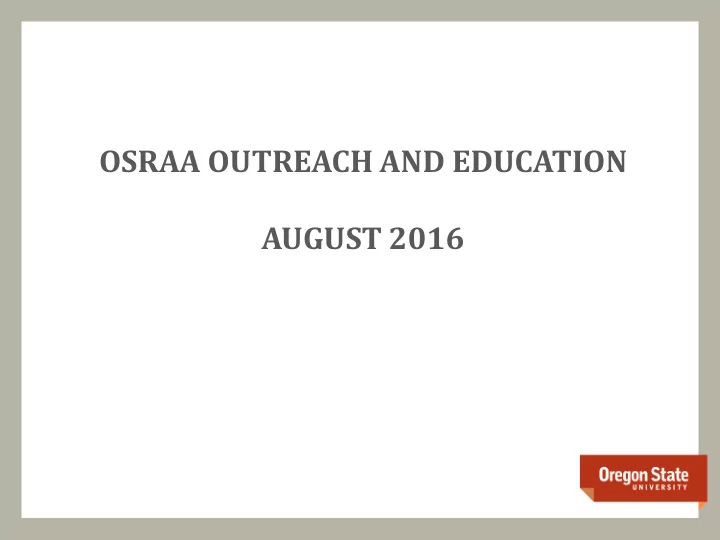

OSRAA OUTREACH AND EDUCATION AUGUST 2016
Today’s Agenda • What’s new on the OSRAA Website • Policies and Procedures Updates • Effort Reporting
Effort Reporting Policy • Reason for policy – FY15 Internal Audit on Effort Reporting • PAR certification was not consistently done • Untimely submission • No escalation process • No periodic reviews done to ensure appropriate personnel with adequate knowledge of work are certifying PARs
Where will I find these new policies? • http://research.oregonstate.edu/osraa/getting-started/policies
Other Considerations on Effort Reporting • The Uniform Guidance!
The Uniform Guidance and Effort Reporting/Certification There’s actually more flexibility in the UG The “Examples of Acceptable Methods for Payroll Distribution” are gone The UG refers to “remuneration” as opposed to “compensation” The UG indicates that compensation for personal services has to follow an appointment made in accordance with our “laws and/or rules or written policies” The UG doesn’t expressly require effort certification The UG tells us that institutions need a written policies governing outside activities It also indicates that an awarding agency may restrict outside activities if they believe it’s “excessive” or if it would conflict with terms and conditions of an award. [200.430(c)] A key point for institutions of higher education is a policy on what constitutes institutional base salary
Institutional Base Salary Definition from the UG: “The annual compensation paid by an institution of higher education (IHE) for an individual’s appointment, whether that individual’s time is spent on research, instruction, administration or other activities.” Good policies defining what goes into the Institutional Base Salary (IBS) is critical
Other Policy Considerations related to compensation Extra Service Pay The UG indicates that this “normally represents overload compensation, subject to institutional compensation policies for services above and beyond IBS” Extra Service Pay is subject to Standards for Documentation [200.430(i)], but not part of IBS (if it’s not part of IBS, it isn’t part of the “100% of compensated activities”)
Standards for Documentation of Personnel Expenses There are 9 standards
Standard 1 “Charges to Federal awards for salaries and wages must be based on records that accurately reflect the worked performed.” These records “must be supported by a system of internal control which provides reasonable assurance that the charges are accurate, allowable and properly allocated”
Standard 2 The charges must “be incorporated into the official records” of the institution/organization (the UG calls us a non-Federal Entity)
Standard 3 The charges must reasonably reflect the total activity for which the employee is compensated and not exceed “100% of compensated activities” For Institutions of Higher Education, this would be the definition of institutional base salary
Standard 4 The charges must “encompass both federally assisted and all other activities compensated” The UG does allow use of integrated subsidiary records, as long as your institutional written policy outlines those subsidiary records
Standard 5 The charges comply with the institution’s established accounting policies and practices
Standard 6 The charges support the distribution of the employee’s compensation among specific activities or cost objectives. Examples of this would be instruction, research, and committee work
Standard 7 Budget estimates do not—in and of themselves—qualify as support for charges, but can be used for interim accounting if: “The system for establishing the estimates produces reasonable approximations of the activity actually performed” “Significant changes in the corresponding work activity” are identified and entered into the system in a timely manner Internal controls include a review of after-the-fact interim charges and accurate adjustments are made
Standard 8 Institutions of higher education are allowed to reflect categories of activities as a percentage distribution of total activities (the UG still recognizes that practices vary as to what constitutes a full workload”
Standard 9 The UG still recognizes that teaching, research, services and administration are “often inextricably intermingled in an academic setting” and “a precise assessment of factors” that contribute to charging salaries and wages “is therefore not always feasible, nor is it expected”.
Recommend
More recommend